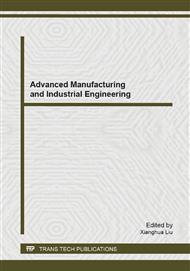p.381
p.386
p.390
p.394
p.398
p.403
p.407
p.411
p.415
Predicting Tool Point FRF by RCSA in High Speed Milling
Abstract:
Tool point frequency response function (FRF) is the key parameters to predict the milling stability in high-speed milling. Receptance coupling substructure analysis (RCSA) is described to predict the tool point FRF. The major difficulties in RCSA are the identification of joint connection parameters and the obtaining of FRFs of substructure. This paper separation of the milling system into three substructures: the machine-spindle-holder taper, the extended holder-tool shank, and the tool extended portion. Develop the connection model compose of linear and rotational springs and dampers. Determine the substructure FRF by measurement and Euler-Bernoulli beam model. Tool point FRF is obtained by coupling the substructure FRFs through the connection model by RCSA.
Info:
Periodical:
Pages:
398-402
Citation:
Online since:
August 2014
Authors:
Price:
Сopyright:
© 2014 Trans Tech Publications Ltd. All Rights Reserved
Share:
Citation:


